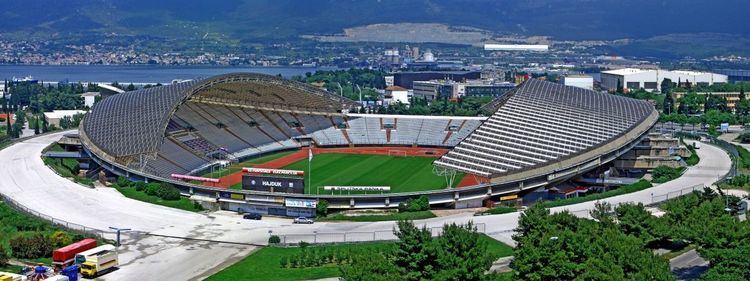Capacity 35,000 | Surface Grass Architect Boris Magas̆ | |
 | ||
Full name Gradski stadion u Poljudu Field size 105 m x 68 m (115 yd x 74 yd) Address 8 Mediteranskih Igara 2, 21000, Split, Croatia Similar Stadion Maksimir, Marjan, Stadion Kantrida, Diocletian's Palace, Stadion Stari plac | ||
Drone flight over stadion poljud in split croatia
Stadion Poljud is a multi-use stadium in the Croatian city of Split. It takes its name from the neighbourhood of Poljud, and is located on the northern side of the Split peninsula. Its original name is "Gradski stadion u Poljudu" ("City Stadium in Poljud"). The stadium was built in 1979 and is the home venue of the Hajduk Split football club. Some of the Croatian national football team's games are played at Poljud, which competes with Maksimir stadium for the biggest matches. The stadium has a capacity of 35,000.
Contents
- Drone flight over stadion poljud in split croatia
- 35 000 croatians sing dalmacijo at stadion poljud hajduk split vs inter milan august 2 2012
- Design
- References
The venue was built to host the 1979 Mediterranean Games and was opened by the then Yugoslav president, Josip Broz Tito. It had an original capacity of 55,000, increased to 62,000 in the 1980s, before being equipped with seats in the 1990s thus reducing the capacity to 35,000.
Poljud Stadium was also the venue for the 1990 European Athletics Championships and the 2010 IAAF Continental Cup, and since 2013, it annually hosts Ultra Europe.
35 000 croatians sing dalmacijo at stadion poljud hajduk split vs inter milan august 2 2012
Design
It's trademark is an impressive seashell-like design with roof structure spanning at 205x47 meters, that has been copied by a large number of world stadiums in the years that followed. It was designed as transparent offering views of nearby hills and forests from the stands, modeled after ancient Greek theaters. Suspended on the west roof "shell" are 19 cabins, 7 of them are used by TV reporters, and other filled by the cameras, central referee station, photo finish, scoreboard and audio control etc. All of these are interconnected via catwalk, that runs through a structure spanning the entire roof giving access to the cabins, as well as to the 630 Philips lights, placed brim and inner side of the roof. The lighting on the stadium has also been the subject of much acclaim.
Stands are supported by a construction of reinforced concrete with entrances via 12 bridges placed 30–40 meters apart around the entire stadium as well as eight staircases. Underneath them is a trench holding office areas. Area around the stadium is composed of 60,000 square meters of designed landscape with greenery designated for pedestrians with stadium slightly beneath the grade level of surrounding traffic roads. Placed under the western stands there are 11,000 square meters of sports facilities (three gyms, pool, sauna), official club offices and restaurants, while eastern stands cover 9,100 square meters of business areas. Battleground is composed of 105x68 meters football pitch and 8 running tracks surrounding it.
It was refurbished before hosting the 2010 IAAF Continental Cup athletics competition. New tartan track was constructed, including the introduction of new VIP boxes and seats. In October 2014, following the heavy damage from Ultra Europe, new pitch and drainage system were constructed, replacing the original ones that lasted for 35 years.
In November 2015 the stadium was officially recognized as culture heritage.
